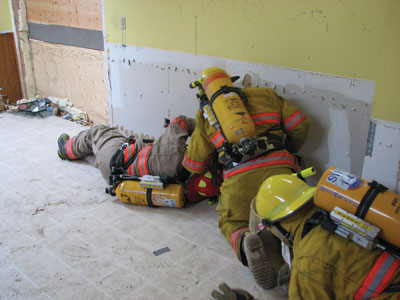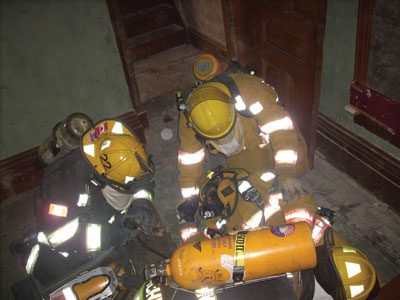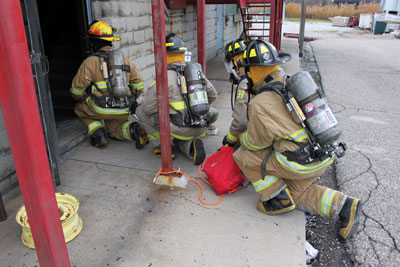
Features
Training
Back to Basics: April 2012
Properly staffing the rapid intervention team (RIT) is essential when conducting any kind of fire attack.
April 4, 2012
By Mark van der Feyst
Properly staffing the rapid intervention team (RIT) is essential when conducting any kind of fire attack. NFPA and other regulations or guidance notes require a minimum of two firefighters on a RIT to ensure the necessary tasks can be completed and to allow an incident commander to initiate an interior fire attack with minimal staffing.
 |
|
| A two-person search team locates a mayday firefighter using a right-hand search. Photos by Mark van der Feyst
|
Having just two firefighters on a RIT is not sufficient. In RIT training, instructors show the difference between a two-person and a four-person team, and compare the effectiveness of two- and four-person squads.
A two-person RIT is labour intensive for a number of reasons:
1. The amount of equipment team members need to bring with them.
- The basic equipment needed is two sets of hand tools, the RIT pack containing an SCBA cylinder and hardware, a thermal imaging camera (TIC), a flashlight and a portable radio.
- The RIT bag can be very heavy and awkward to carry, or it can be light and convenient to carry, depending on the size and the amount of equipment packed into it. RIT kits are usually packed full of hand tools and gadgets and this makes the kit heavy. Ensure that the necessary equipment needed is present and remove all the extras.
2. Two people are doing the job of four.
- When faced with obstacles or hazards, there are just two people available to navigate and physically remove any debris. This task alone will fatigue a two-person team.
3. The search operation requires both members to be together at all times.
- For accountability purposes, the team must stay together. A four-person team can conduct an oriented-type of search or a TIC-assisted search.
The two-person RIT will have to use the building’s features to conduct either a left-hand or a right-hand search. Using a TIC is beneficial but team members still require physical contact with the building to maintain orientation, as the building will be the exit lifeline. This type of search is slow and contributes to fatigue of team members.
 |
|
| A four-person search team assesses and packages a mayday firefighter. | |
 |
|
| A four-person search team ready for deployment. Notice how the rope bag is secured to a stationary object.
|
A primary search has to be quick. Fire victims can be missed in a quick search because not every area is checked thoroughly. A two-person team needs to search quickly but will be able to check only the area along the perimeter as they do a left- or right-hand search. This greatly increases the chances of failing to find the mayday firefighter.
The two-person search team starts searching for the mayday firefighter at his last-known location. The accountability officer or incident commander can communicate this to RIT members – this is why the accountability system needs to be kept up to date about the status of the interior operating crews.
Once members of the RIT find the mayday firefighter, they will have to assess, package and remove him. If first-in team members have to complete all these tasks, they will become fatigued and may have a tough time removing the mayday firefighter; it’s better to have four people on a RIT as they can rotate these tasks.
A four-person RIT reduces the intensity of the operation because there are twice as many people to carry the required equipment, remove debris and navigate obstacles. RIT members can work in two teams – two to locate the mayday firefighter and two to complete the removal process.
The search for a mayday firefighter using a four-person team is quicker and more direct. Instead of using a left- or right-hand search pattern, team members can use a direct approach by listening for the mayday firefighter’s PASS alarm. The sound of the alarm guides the RIT members to the mayday firefighter and this results in faster packaging and removal.
The main difference between the two-person and the four-person search team is the addition of a search rope. The search rope is the lifeline for the four-person RIT members; it will guide them out should they need to evacuate.
Rope should be between 7.5 and nine millimetres. This size allows firefighters to move freely (because it isn’t too heavy) and easily carry a bag with 100 feet of rope without adding too much bulk.
The last firefighter on the team should carry the rope bag so that it doesn’t get tangled around furniture or team members. The rope bag must be secured outside, around a stationary object, so that it is properly anchored; this alleviates any possibility of the rope becoming untied from the safety landmark.
The first firefighter from the four-person search team leads the team toward the sound of the PASS alarm and should carry a Halligan and the TIC. The TIC will help with navigation.
The second firefighter should also carry a hand tool to help the first firefighter.
The third firefighter carries the RIT bag and the last firefighter manages the rope bag.
(You can refer to the January 2010 edition of Back to Basics for specific instructions on the rope deployment – go to www.firefightingincanada.com and click on past issues.)
If the manpower is available, a four-person search team increases efficiency and makes the rescue of a mayday firefighter that much quicker.
Mark van der Feyst is a 13-year veteran of the fire service. He works for the City of Woodstock Fire Department in Ontario and teaches in Canada, the United States and India. Mark is a local-level suppression instructor for the Pennsylvania State Fire Academy and an instructor for the Justice Institute of British Columbia. Contact him at Mark@FireStarTraining.com
Print this page